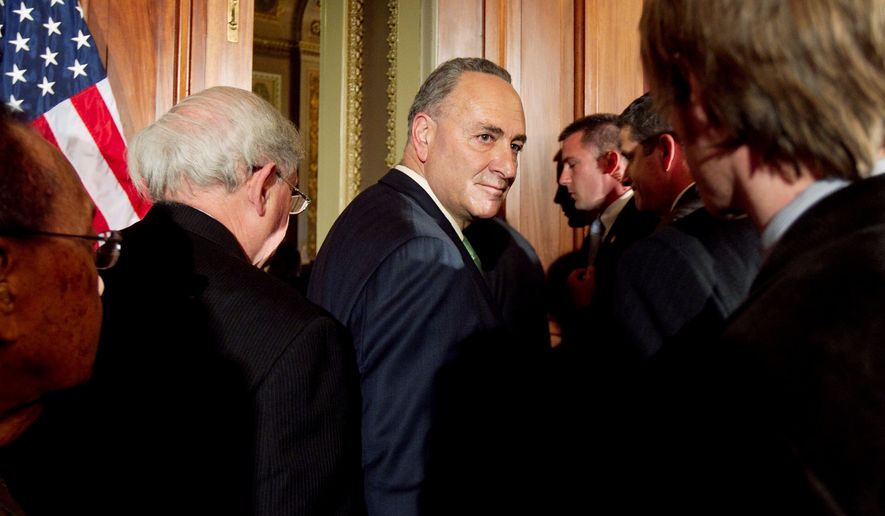The final 2011 spending deal that Congress released Tuesday bears the fingerprints of Democrats far more than Republicans, whose effort to slash the federal deficit was swamped by President Obama’s tenacious defense of spending programs.
Chief among those fingerprints were those of Sen. Charles E. Schumer, the New York Democrat who was the first major player to suggest shifting some cuts from discretionary spending to mandatory spending — a key decision that allowed the total dollar amount of cuts to grow, while not slashing the basic programs Democrats wanted to protect.
That has left all sides to claim victory: the GOP, because it earned $37.7 billion in cuts, which is more than half of its original $61 billion target, and Democrats because they blunted Republicans’ budget hatchet and blocked the deepest reductions, leaving base-line discretionary cuts of about $15 billion.
“A deal became possible once Republicans agreed to our idea of including reductions in mandatory programs,” Mr. Schumer said. “That’s what allowed the negotiators to reach the $38 billion number in total cuts. We will look to broaden the playing field even further in the spending debates to come so the sacrifice is shared across all parts of the budget. You can’t balance the budget by cutting domestic discretionary spending alone.”
The agreement that Democrats reached with House Speaker John A. Boehner, Ohio Republican, was released in full early Tuesday. It preserves the big-dollar education, environment, job-training and public broadcasting programs that the GOP had tried to ax.
Gone are the major billion-dollar cuts to public housing, the Corporation for National and Community Service, the National Institutes of Health and job-training grants. All of those cuts were passed by the House, but the money was restored in the final deal.
The discretionary spending cuts that were left trim hundreds of programs, but the biggest single chunks come from savings that would have happened anyway: $6.5 billion in recapturing unspent money from previous years, and an additional $6.2 billion reduction in Census Bureau spending, which was artificially high last year because of the 2010 census.
That means actual discretionary base-line cuts come to about $15 billion, or less than a third of what House Republicans passed.
“It’s more than we’ve ever done, but when you look at what’s ahead and what we’re going to have to do, it’s pretty small,” said Rep. Jeff Flake, Arizona Republican, a budget hawk who said he has not decided how he will vote, but said Republicans should have pushed harder on the front end.
“We should have gone in with $100 billion [in cuts]. You know you’re going to meet somewhere in the middle; then by golly, go in with a big number,” he said.
Almost all of the cuts in House Republicans’ initial $61 billion bill came from discretionary spending, but in the final deal nearly half of the money comes from mandatory programs, as Mr. Schumer had suggested.
Discretionary spending is money Congress approves every year, and cuts get multiplied over the year because of the magic of compound interest. It is usually seen as aiding the poor.
Mandatory spending automatically rises based on formulas, and so could easily jump back up next year. Conservative critics said it also is more susceptible to gimmicks.
The bill must be approved by Friday or else the government, which is operating on a one-week stopgap measure, risks running out of funding and could shut down.
In the immediate aftermath of the late-Friday deal, when just the outline was known, pundits said Republicans had gotten the best of the fight, since the $37.7 billion number was closer to House Republicans’ $61 billion cuts than it was to Democrats’ proposed freeze.
But the specific cuts weren’t released until early Tuesday morning, and Democrats are now arguing that they successfully blunted the GOP’s assault on spending.
“We fought for cuts, but they had to be smart cuts, cuts that would strengthen our economy instead of weakening it,” Senate Majority Leader Harry Reid, Nevada Democrat, told reporters.
He said criticism this week from radio talk-show host Rush Limbaugh could help boost support for the deal among Senate Democrats.
The bill calls for the government to spend $1.049 trillion for the remainder of fiscal 2011, which is $37.7 billion lower than 2010 levels.
Still, the size of those cuts is dwarfed by the projected deficit, which is expected to be about $1.5 trillion this year. The deficit for March alone was $188 billion, or five times the cuts made in the full-year bill.
“There’s no philosophy guiding these cuts,” said Tad DeHaven, budget analyst at the Cato Institute, a think tank that pushes for limits to government. “It’s like they went through the books and cleared out the cobwebs, and found areas where they could save some money and get a deal done.”
Republicans, though, said they have managed to change the conversation in Washington, shifting from how much spending to how much cutting.
“The ground shifted,” said Senate Minority Leader Mitch McConnell, Kentucky Republican. “Spending reductions Democrats recently described as ’extreme’ and ’draconian,’ they are now calling ’historic’ and ’common sense.’ The debate has turned from how much to grow government to how much to reduce it.”
• Stephen Dinan can be reached at sdinan@washingtontimes.com.




Please read our comment policy before commenting.